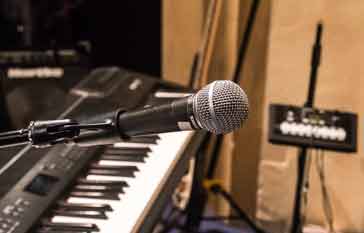Microphone for Singing / Vocals - performance & recording
All microphones are different, so it is necessary to choose the best microphone for vocals / singing whether performing or recording.
Microphone Tutorial Includes:
Microphone basics
Microphone types
Microphone specs
Microphone directionality
Dynamic microphone
Condenser microphone
Electret microphone
Ribbon microphone
Crystal / ceramic microphone
Boundary / PZM microphone
Carbon microphone
How to buy best microphone
Microphones for video
Microphones for vocals/ singing
There is a huge number of microphones of all types available. Choosing the right microphone for singing or vocals may not be easy at first sight, but it is possible to have some good pointers so the best microphone can be chosen for singing or vocals whether performing on stage or recording in a studio.
Choosing the best vocals microphone for performance or studio recording will ensure that the best quality can be achieved and the best effect obtained for the singer.
The choice of microphone may vary between live performance and recording, so the points relating to the choice of the best vocals microphone will be addressed in two sections so that live performance and recording can be addressed separately.

Best microphone for performance vocals
When singing on stage to a live audience the type of microphone used will tend to need to be robust whilst still being able to provide a faithful reproduction of the singer. The microphone needs to provide a good "presence" whilst also not adding to any issues with acoustic feedback.
Another requirement is that the microphone needs to be robust. Any microphone that is used on stage will suffer knocks and bangs and it needs to be able to survive these. Normally this means that dynamic microphones are best, although sometimes capacitor or condenser microphones may also be used.
Dynamic microphones have the advantage that being long and thin, they can be mounted in a holder, and use on a stand, or they can be handheld, something which many artist like.
Although we try not to review specific microphones or equipment, the Shure SM58 is slightly different. It has been, possibly the most widely used live vocals microphone. It is robust and its dynamic capsule has a good cardioid polar pickup pattern that makes it an effective vocal microphone removing a lot of unwanted noise and ambience from different directions. The SM58 also produces accurate and pronounced vocals, often with a little top lift to provide crispness and presence.
The SM58 microphone has been relied upon by some of the worlds leading artists and almost every stage in the world for over 50 years. It is widely used by broadcasters for live music performance by popular music artists, and all of this is achieved without a huge price tag. In fact some my ask why such a good microphone is so cheap.
If the microphone is to be chosen for a particular singer, then it is good to trial one if t all possible. All microphones are different and suit some singers better than others.
Microphones for recording vocals
The requirements for microphones that are used in a recording studio can be different to those for microphones for live performances of vocals. There is naturally some overlap, but often different microphones are used.
Although dynamic moving coil microphones like the Shure SM58 are often used in view of their performance, for studio work condenser microphones tend to be used more frequently.
There are many condenser microphones that can be bought. These microphones are capable of providing very high levels of performance.
Condenser microphones are very good for recording vocals because they offer a very wide frequency range and often the frequency response is flatter than some of the dynamic microphones. This gives a better option for later altering the recording in the post production stages of the recording.
When using condenser microphones, there is a good range of pop filters that can be added directly to the mounts. This prevents the annoying pops that can occur when saying sounds like p, b, and the like.
In addition to this some condenser microphones can come with an anti-vibration mount that considerably reduces the transmission of any vibration in the building to the microphone. In this way much les noise can be present on the recording.
 Written by Ian Poole .
Written by Ian Poole .
Experienced electronics engineer and author.
More Audio Video Topics:
HDMI
SCART
DisplayPort
DVI
Loudspeaker technology
Headphones & earphones
Bluetooth speakers
Stereo sound
Microphones
Audio compact cassettes
Vinyl record technology
Digital radio
DVB television
Return to Audio / Video menu . . .



